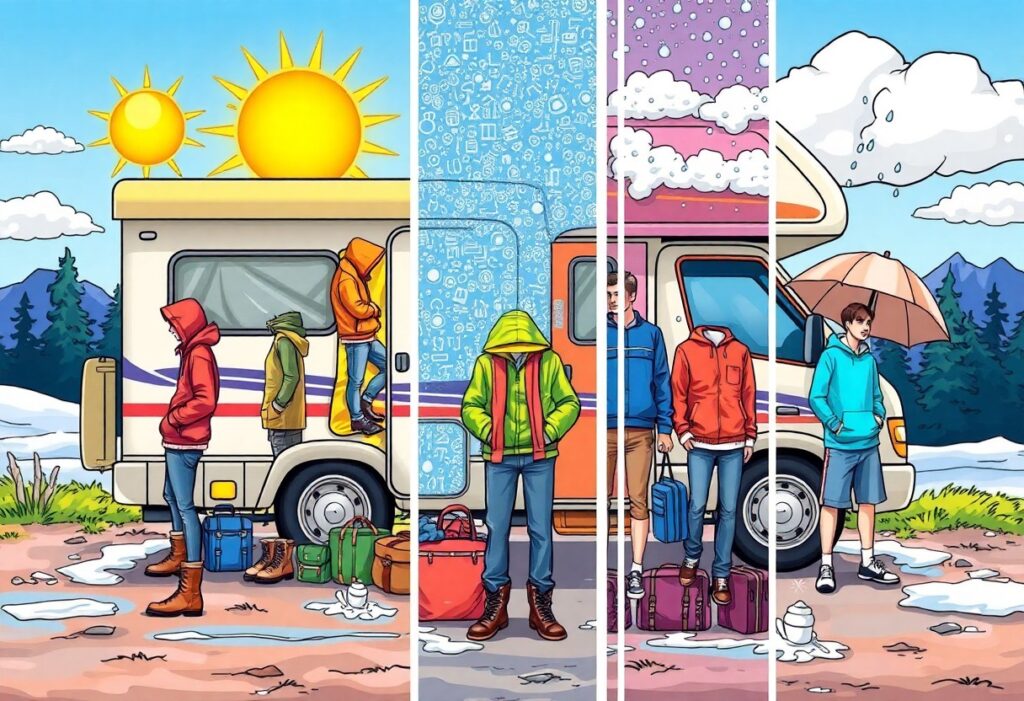This guide will equip you with vital tips for packing clothing and footwear suited to the unpredictable weather you may encounter on your RV trip. Whether you’re heading into the mountains, along the coast, or visiting national parks, understanding how to prepare for diverse climates is vital for your comfort. You’ll learn how to select versatile pieces, optimize space, and bring the right footwear, ensuring that you’re ready for whatever Mother Nature throws your way while enjoying your adventure on the road.
Understanding Weather Factors
While planning your RV trip, it’s crucial to understand the various weather factors that can influence your travel experience. Consider the following:
- Temperature fluctuations
- Precipitation levels
- Wind conditions
- Humidity and its effects
- Weather forecasts for your route
Thou should prepare accordingly to ensure comfort and safety throughout your journey.
Seasonal Considerations
Assuming you are traveling during different seasons, it’s imperative to pack attire that is suitable for winter, spring, summer, and fall. Each season presents unique weather challenges; layering can be your best strategy during transitional months to adapt to temperature swings throughout the day.
Regional Climate Variations
You should also factor in regional climate variations when packing for your RV trip. Different areas experience diverse weather patterns, so understanding the climate of your destination will help you select the appropriate clothing and footwear.
To ensure you’re well-prepared, research the typical weather conditions of the regions you’ll be visiting. Coastal areas may be humid with potential rain, whereas mountainous regions could be cooler, requiring warmer layers. Checking seasonal weather averages can save you from unpleasant surprises, ensuring you have a comfortable experience during your travels.
How to Choose Appropriate Clothing
Some factors to consider when choosing clothing for your RV trip include the destination’s climate, activities planned, and duration of your stay. Opt for versatile pieces that can mix and match easily, allowing you to create multiple outfits without overpacking. Consider the expected weather conditions and be prepared for unexpected changes, ensuring your clothing selection accommodates a range of temperatures and weather patterns.
Layering Techniques
On your RV journey, layering is an effective way to stay comfortable in fluctuating temperatures. Start with a lightweight base layer that wicks moisture, add an insulating layer for warmth, and finish with a waterproof and windproof outer layer. This way, you can easily adjust your clothing as the weather changes throughout the day.
Fabric Selection
Some materials are better suited for outdoor activities than others, and selecting the right fabrics can enhance your comfort. Look for moisture-wicking, quick-drying, and breathable fabrics for base layers, while fleece or down are excellent choices for insulation. Your outer layer should be durable and weather-resistant to protect you from the elements.
With various fabric options available, prioritize lightweight and compact materials to save space in your RV. Synthetic fabrics such as polyester and nylon often provide superior moisture management, while merino wool offers excellent insulation and breathability. Avoid heavy cotton, as it retains moisture and can leave you feeling cold and damp. By choosing the right fabrics, you can ensure your clothing performs well, keeps you comfortable, and simplifies your packing process.
Packing Tips for Footwear
There’s a lot to consider when packing footwear for your RV trip. To ensure you have the right pair for any situation, follow these helpful guidelines:
- Choose versatile shoes that can be used for multiple activities.
- Consider the climate and terrain you’ll be encountering.
- Utilize packing cubes or bags to keep shoes organized.
- Bring an extra pair for unexpected weather changes.
This will keep your footwear selection efficient and practical.
Types of Footwear for Different Weather
Different conditions require specific types of footwear for optimal comfort and protection. Here’s a quick guide:
| Weather | Recommended Footwear |
| Hot and Sunny | Sandals or breathable sneakers |
| Rainy | Waterproof boots or shoes |
| Cold and Snowy | Insulated boots |
| Mild and Pleasant | Lightweight sneakers or loafers |
Thou can pick the appropriate styles based on your travel plans.
Space-Saving Packing Methods
Tips for packing your footwear efficiently can make a big difference in your RV space. Here are some strategies:
- Stuff socks or smaller items inside your shoes.
- Opt for lightweight and foldable shoes when possible.
- Use compression bags to reduce volume.
- Separate pairs with a washcloth or small packing cubes.
Understanding how to effectively pack your footwear will help you maximize your RV’s limited space while ensuring you have everything you need for your trip. By employing these techniques, you’ll find it much easier to keep your footwear selection as organized and accessible as possible.
Essential Accessories for All Weather
Once again, well-prepared RV travelers know that having the right accessories can make your journey more enjoyable, regardless of the weather conditions. Packing versatile items that suit various climates will keep you comfortable and ready for anything nature throws your way. From layering options to protective gear, ensuring you have these importants can elevate your RV experience and keep you enjoying the great outdoors.
Rain Gear and Cold Weather Essentials
Little do some travelers realize that unexpected weather shifts can occur, so having a reliable rain jacket, waterproof boots, and thermal layers is important for staying dry and warm. Investing in quality, lightweight, and packable items will save space while ensuring you’re prepared for wet or chilly conditions. Don’t forget gloves and a beanie to keep those extremities warm!
Sun Protection and Ventilated Items
Weather can be unpredictable, but protecting yourself from the sun is a constant necessity. Items like wide-brimmed hats, UV-protection sunglasses, and lightweight long-sleeve shirts can help shield your skin from the harsh rays while keeping you cool during warm outings.
It’s important to select breathable fabrics that wicks moisture away from your skin, enabling you to stay comfortable even in high temperatures. Consider packing a lightweight, foldable sun shelter or pop-up tent for additional shade during outdoor activities. By prioritizing sun protection and ventilation, you will enhance your overall comfort and safety throughout your RV trip.
Organizing Your RV Storage
Despite the limited space in an RV, effective organization can maximize your storage capacity and keep your travels stress-free. By neatly arranging your belongings, you’ll find it easier to access your clothing and footwear when the weather changes unexpectedly. Utilizing storage bins, shelves, and unique compartments will not only help you maintain order but also make it easier to keep track of your imperatives during your trip.
Designating Packing Areas
Even in a small space, designating specific packing areas can streamline your organization process. Choose specific compartments or drawers for different categories, such as clothing, shoes, and gear, allowing you to locate items quickly when you need them. This way, you’ll reduce the time spent searching for imperatives and enjoy more time on the open road.
Using Packing Cubes and Bins
Organizing your clothing and footwear using packing cubes and bins can be incredibly beneficial. These tools can separate your items by type or season, making it easy to find what you need without rummaging through your entire stash.
The best part about packing cubes is that they are lightweight and can fit into various spaces within your RV, from under the bed to above cabinets. Allocating a designated cube for specific weather conditions—like rain gear, summer outfits, or winter wear—allows you to switch your wardrobe effortlessly as the seasons change. Additionally, bins can store shoes neatly and protect them from dirt, helping maintain cleanliness in your RV. This organizational method will enhance your travel experience by keeping everything straightforward and at your fingertips.
Safety and Emergency Gear
All RV trips come with their own set of challenges, and preparing for unexpected situations is important. Having the right safety and emergency gear can make all the difference in ensuring you and your companions stay safe during your travels. This includes clothing and tools for unpredictable weather as well as a well-organized personal emergency kit to address any unforeseen circumstances.
Clothing and Tools for Unexpected Weather
While hitting the road, it’s wise to pack versatile clothing that layers easily for temperature fluctuations. Be sure to include waterproof outerwear, sturdy footwear, and accessories like hats and gloves. Additionally, packing tools such as a portable weather radio and a blanket can help you stay prepared for sudden changes in weather.
Creating a Personal Emergency Kit
There’s always a chance that emergencies can arise during your RV adventure, so assembling a personal emergency kit is a smart step. Your kit should include important items like a first-aid kit, flashlight, multi-tool, and non-perishable snacks to keep you stocked in unexpected situations.
With an effective personal emergency kit, you ensure that you are well-equipped for any situation that may arise. Include items such as extra batteries, maps, a whistle, and a firestarter to cover various scenarios. Tailor your kit to suit your specific travels, and review its contents regularly to keep everything fresh and functional. Having these supplies can provide peace of mind, allowing you to enjoy your trip with added confidence.
Conclusion
Taking this into account, planning your clothing and footwear for varying weather on your RV trip requires thoughtful consideration. By assessing the forecast and factoring in layering options, you can ensure that you are prepared for any changes in temperature or climate. Packing versatile items, and incorporating waterproof gear, will help you stay comfortable and enjoy your journey. Ultimately, being well-prepared will enhance your RV experience, allowing you to focus on the adventure ahead rather than worrying about your wardrobe.

